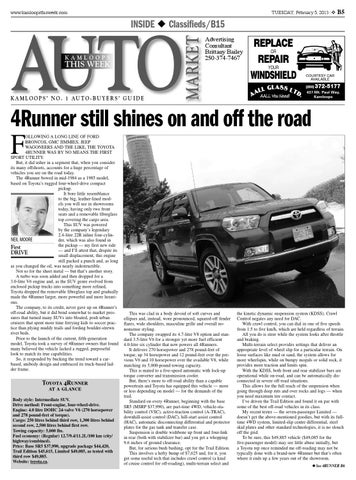www.kamloopsthisweek.com
TUESDAY, February 5, 2013
B5
AUTO KAMLOOPS
THIS WEEK
K A M L O O P S ’ N O . 1 AU T O - B U Y E R S ’ G U I D E
MARKET
INSIDE X Classifieds/B15 Addvertising Advertising Consultant Con nsultant Brittany Bri ittany Bailey 250-374-7467 250 0-374-7467
REPLACE OR REPAIR YOUR WINDSHIELD
COURTESY CAR AVAILABLE
372-5177 372-5177
(250)
AALL You Need!
437 Mt. Paul Way, Kamloops
4Runner still shines on and off the road
F
OLLOWING A LONG LINE OF FORD BRONCOS, GMC JIMMIES, JEEP WAGONEERS AND THE LIKE, THE TOYOTA 4RUNNER WAS BY NO MEANS THE FIRST SPORT UTILITY. But, it did usher in a segment that, when you consider its many offshoots, accounts for a huge percentage of vehicles you see on the road today. The 4Runner bowed in mid-1984 as a 1985 model, based on Toyota’s rugged four-wheel-drive compact pickup. It bore little resemblance to the big, leather-lined models you will see in showrooms today, having only two front seats and a removable fibreglass top covering the cargo area. This SUV was powered by the company’s legendary 2.4-litre 22R inline four-cylinNEIL MOORE der, which was also found in the pickup — my first new ride First — and I’ll attest that, despite its DRIVE small displacement, this engine still packed a punch and, as long as you changed the oil, was nearly indestructible. Not so for the sheet metal — but that’s another story. A turbo was soon added and then dropped for a 3.0-litre V6 engine and, as the SUV genre evolved from enclosed pickup trucks into something more refined, Toyota dropped the removable fibreglass top and gradually made the 4Runner larger, more powerful and more luxurious. The company, to its credit, never gave up on 4Runner’s off-road ability, but it did bend somewhat to market pressures that turned many SUVs into bloated, posh urban cruisers that spent more time ferrying kids to soccer practice than plying muddy trails and fording boulder-strewn river beds. Prior to the launch of the current, fifth-generation model, Toyota took a survey of 4Runner owners that found many believed the vehicle lacked a rugged, purposeful look to match its true capabilities. So, it responded by bucking the trend toward a carbased, unibody design and embraced its truck-based ladder frame.
Toyota 4Runner at a glance Body style: Intermediate SUV. Drive method: Front-engine, four-wheel-drive. Engine: 4.0 litre DOHC 24-valve V6 (270 horsepower and 278 pound-feet of torque). Cargo: 250 litres behind third row, 1,300 litres behind second row, 2,500 litres behind first row. Towing capacity: 5,000 lbs. Fuel economy: (Regular) 12.7/9.4/11.2L/100 km (city/ highway/combined). Price: Base SR5 $37,990, upgrade package $44,420, Trail Edition $45,615, Limited $49,085, as tested with third row $49,885. Website: toyota.ca.
This was clad in a body devoid of soft curves and ellipses and, instead, wore pronounced, squared-off fender flares, wide shoulders, masculine grille and overall nononsense styling. The company swapped its 4.7-litre V8 option and standard 3.5-litre V6 for a stronger yet more fuel efficient 4.0-litre six cylinder that now powers all 4Runners. It delivers 270 horsepower and 278 pound-feet of torque, up 34 horsepower and 12 pound-feet over the previous V6 and 10 horsepower over the available V8, while matching its 5,000-pound towing capacity. This is mated to a five-speed automatic with lock-up torque converter and transmission cooler. But, there’s more to off-road ability than a capable powertrain and Toyota has equipped this vehicle — more or less depending on model — for the demands of the trail. Standard on every 4Runner, beginning with the base SR5 (MSRP $37,990), are part-time 4WD, vehicle-stability control (VSC), active-traction control (A-TRAC), downhill-assist control (DAC), hill-start assist control (HAC), automatic disconnecting differential and protector plates for the gas tank and transfer case. Suspension is double wishbone up front and four-link in rear (both with stabilizer bar) and you get a whopping 9.6 inches of ground clearance. But, for serious bush bashing, opt for the Trail Edition. This involves a hefty bump of $7,625 and, for it, you get some useful tech that includes crawl control (a kind of cruise control for off-roading), multi-terrain select and
the kinetic dynamic suspension system (KDSS). Crawl Control negates any need for DAC. With crawl control, you can dial in one of five speeds from 1.5 to five km/h, which are held regardless of terrain. All you do is steer while the system looks after throttle and braking. Multi-terrain select provides settings that deliver an appropriate level of wheel slip for a particular terrain. On loose surfaces like mud or sand, the system allows for more wheelspin, while on bumpy moguls or solid rock, it provides more traction and limits spin. With the KDSS, both front and rear stabilizer bars are operational while on-road, and can be automatically disconnected in severe off-road situations. This allows for the full reach of the suspension when going through deep ruts and over rocks and logs — when you need maximum tire contact. I’ve driven the Trail Edition and found it on par with some of the best off-road vehicles in its class. My recent tester — the seven-passenger Limited — doesn’t get the above-mentioned goodies, but with its fulltime 4WD system, limited-slip centre differential, steel skid plates and other standard technologies, it is no slouch off the grid. To be sure, this $49,885 vehicle ($49,085 for the five-passenger model) may see little abuse initially, but a Toyota rep once reminded me off-roading may not be typically done with a brand-new 4Runner but that’s often where it ends up a few years out of the showroom. X See 4RUNNER B6
